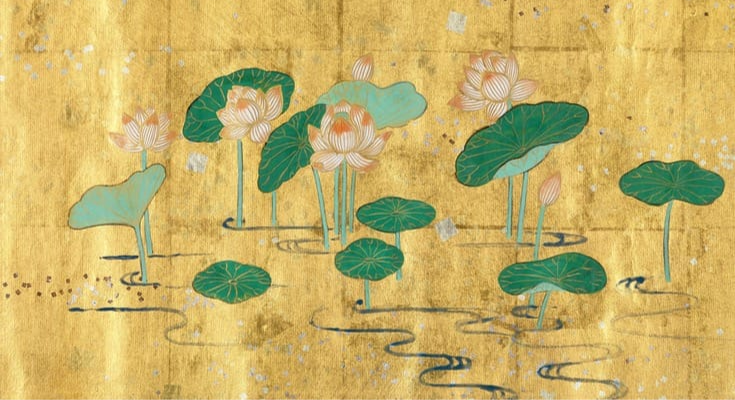Mahayana Buddhism, one of Buddhism’s three vehicles, is considered the greater vehicle. It emphasizes Bodhicitta, the awakening mind aspiring toward enlightenment for oneself and all sentient beings. This branch places a strong focus on compassion, altruism, and wisdom.
Practitioners follow the Bodhisattva path, striving for Buddhahood to guide others to liberation. The Mahayana tradition, with its rich teachings, sutras, and cultural expressions, has evolved across East Asia, shaping the religious landscape. Emphasizing Sunyata, it asserts the interdependence of all phenomena. Mahayana Buddhism, with its inclusive outlook, continues to inspire millions in their quest for enlightenment and compassion worldwide.
What is Sutra?
Many scriptures are called “sutras” in Sanskrit or “sutta” in Pali. The word “sutra” in the title of a text indicates the work is a sermon of the Buddha or one of his major disciples.
Sutras come in many sizes. Some are book length, some are only a few lines. No one seems willing to guess how many sutras there might be if you piled every individual one from every canon and collection into a pile. A lot.
Not all scriptures are sutras. Beyond the sutras, there are also commentaries, rules for monks and nuns, fables about the lives of the Buddha, and many other kinds of texts also considered to be “scripture.”
While some schools of Buddhism emphasize the study and also the memorization of sutras as a means to understand the nature of practice and to embody the Buddhist teachings, some schools, primarily Zen, emphasize that Buddhist practitioners must not rely on words. “If you say the word ‘fire,’ why doesn’t it burn your lips? If you say the word ‘water,’ why doesn’t it quench your thirst?”
There are three separate canons of Buddhist scriptures. In the Pali Canon of Theravada Buddhism, the sutras are divided into five collections known as the Nikayas (Agamas in Sanskrit), grouped in order of length. These early sutras are all attributed to the historical Buddha, Shakyamuni.
Mahayana Sutras
The Mahayana Sutras are part of what’s called the Chinese Canon. Many of these sutras are also included in the Tibetan Canon.
The Brahma Net (Brahmajala) Sutra
The Brahma Net is a discourse on discipline and morality. In particular, it contains the Ten Bodhisattva Precepts. This Brahmajala Sutra should not be confused with the Brahmajala Sutta of the Tripitaka.
The Brahma Net (Brahmajala) Sutra.pdf
The Avatamsaka Sutra
The Flower Garland Sutra, sometimes called the Flower Ornament Sutra, is a collection of smaller sutras that emphasize the interpenetration of all things. That is, all things and all beings not only reflect all other things and beings but also the Absolute in its totality. The Flower Garland is particularly important to the Hua-yen (Kegon) and Ch’an (Zen) schools.

The Heroic Gate (Shurangama) Sutra
Also called “The Sutra of the Heroic One,” the Shurangama (also spelled Suramgama or Surangama) stresses the importance of samadhi to the realization of enlightenment. The sutra also describes 25 gates to the realization of one’s true nature.
The Jewel Heap (Ratnakuta) Sutra
One of the oldest of the Mahayana Sutras, the Jewel Heap discusses the Middle Way. It provided a basis for the Madhyamaka teachings of Nagarjuna.
The Lankavatara Sutra
Lankavatara means “entering into Sri Lanka.” This sutra describes the Buddha answering questions at an assembly. He expounds upon the “mind only” doctrine, which teaches that individual things exist only as processes of knowing.
Wisdom of the Lotus Sutra (Saddharma Pundarika)
The Lotus Sutra is one of the most well-known and venerated of the Mahayana Sutras. It is particularly important to the T’iantai (Tendai) and Nichiren schools, but it is revered by several other schools of Mahayana.

The Heart Sutra
The Heart Sutra, or Mahaprajnaparamita Hridaya Sutra, is a concise yet profound Mahayana Buddhist scripture. Composed in the form of a dialogue between the venerable Sariputra and the bodhisattva Avalokiteshvara, the sutra is highly revered for its exploration of the concept of emptiness or sunyata.
In just a few lines, the Heart Sutra delves into the nature of reality, challenging conventional perceptions and asserting the interdependence of all phenomena. Its essence lies in the teaching that form is emptiness, and emptiness is form, encapsulating the profound wisdom of the Prajnaparamita or the Perfection of Wisdom teachings. This sutra, considered a jewel of Mahayana literature, has been studied, recited, and revered across various Buddhist traditions for its transformative insights into the nature of existence.

The Mahaparinirvana Sutra – Parinirvana Sutra
The Mahayana Mahaparinirvana Sutra is a collection of sutras said to have been delivered by the Buddha the night before his death. The sutras are primarily about the doctrine of Buddha-nature. The Mahayana Mahaparinirvana Sutra should not be confused with the Mahaparinibanna-sutra of the Pali Canon.
The Perfection of Wisdom (Prajnaparamita) Sutra
The Perfection of Wisdom Sutra is a collection of about 40 sutras. Of these, the best known in the West are the Heart Sutra (Mahaprajnaparamita-hridaya-sutra) and the Diamond (or Diamond Cutter) Sutra (Vajracchedika-sutra). These two brief texts are among the most important of the Mahayana sutras, pointing in particular to the doctrine of sunyata (“emptiness”).
The Pure Land Sutras
Three sutras—the Amitabha; the Amitayurdhyana, also called the Sutra of Infinite Life; and the Aparimitayur—provide the doctrinal basis of the Pure Land school. The Amitabha and Aparimitayur are sometimes also called the shorter and longer Sukhavati-vyuha or Sukhavati Sutras.
The Vimalakirti Sutra
In this sutra, the layman Vimalakirti expounds upon nonduality to a host of high-ranking bodhisattvas. Vimalakirti exemplifies the bodhisattva ideal and reveals that enlightenment is available to anyone, layperson or monastic.



